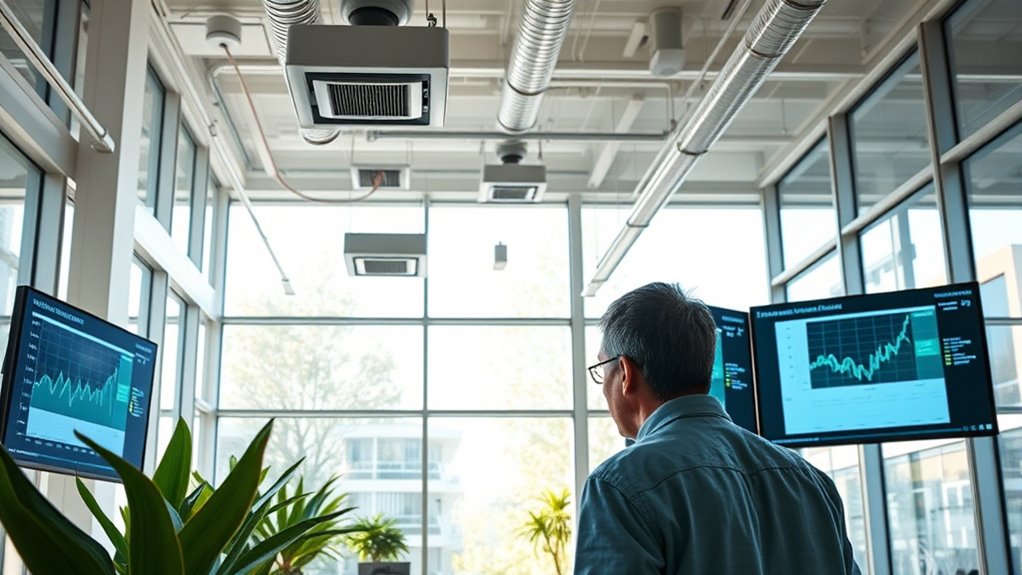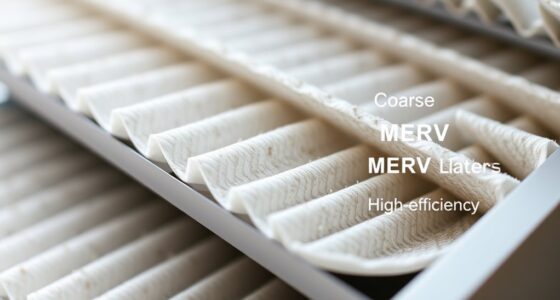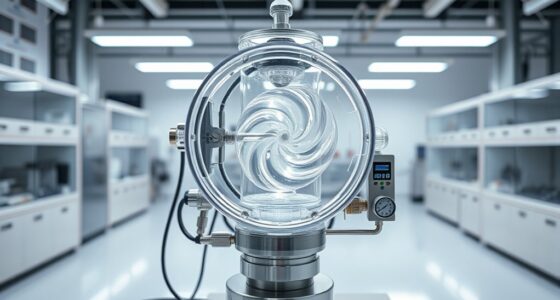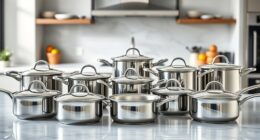To navigate the LEED V5 Fundamental Air Quality Assessment, focus on understanding ventilation strategies that ensure fresh air intake and pollutant removal, along with selecting low-emitting materials to reduce indoor contaminants. Make certain to document and verify system performance through testing and ongoing monitoring. Implementing these steps helps meet certification standards and promotes healthy indoor environments. Keep exploring to uncover how these strategies integrate into your project’s overall sustainability efforts.
Key Takeaways
- Understand LEED V5 requirements for indoor air quality and the role of comprehensive assessments in certification.
- Focus on designing ventilation strategies that ensure adequate outdoor air exchange and pollutant removal.
- Document and verify HVAC system performance through testing, commissioning, and ongoing indoor air quality monitoring.
- Incorporate low-emitting materials and effective filtration to minimize indoor pollutant sources.
- Continuously monitor and adjust ventilation practices to maintain healthy indoor air quality post-occupancy.

Have you ever wondered how building certifications guarantee indoor air quality meets high standards? The answer lies in comprehensive assessments that scrutinize various factors influencing air quality. When pursuing LEED V5 certification, one crucial element is the Fundamental Air Quality Assessment, which ensures that indoor environments are safe and healthy for occupants. This assessment primarily focuses on controlling indoor pollutants—those unseen hazards like volatile organic compounds (VOCs), particulate matter, and other airborne contaminants that can compromise health and comfort. To combat these issues, robust ventilation strategies are incorporated into building design and operation, playing a pivotal role in maintaining optimal air quality.
Ventilation strategies are at the heart of ensuring indoor pollutants are effectively managed. These strategies involve the thoughtful design and implementation of systems that bring fresh air into the building while exhausting stale air. Proper ventilation reduces concentrations of indoor pollutants, dilutes harmful substances, and prevents the buildup of contaminants that could lead to health problems or discomfort. LEED V5 emphasizes the importance of using ventilation systems that meet or exceed standards set by organizations like ASHRAE. This means selecting HVAC systems capable of providing sufficient outdoor air exchange rates, ensuring that indoor air remains fresh and pollutant levels stay low. Additionally, air filtration plays a crucial role in removing airborne contaminants, complementing ventilation efforts.
When navigating the LEED V5 assessment, you’ll find that a key requirement is documenting the effectiveness of these ventilation strategies. This involves detailed analysis of how outdoor air is introduced, circulated, and exhausted throughout the building. It also includes testing and commissioning of HVAC systems to verify they operate as intended. The assessment mandates that building operators monitor indoor air quality parameters over time, ensuring that ventilation continues to effectively control indoor pollutants after occupancy begins. This ongoing monitoring is vital because it helps identify and address any issues before they impact occupant health.
Implementing effective ventilation strategies also involves selecting low-emitting materials and finishes that don’t release harmful indoor pollutants. This proactive approach reduces the burden on HVAC systems and enhances overall indoor air quality. Additionally, proper air filtration and humidity control are incorporated into these strategies to further improve the environment. As you work through the LEED V5 process, you’ll need to demonstrate that these strategies are integrated into your building’s design, construction, and operation, creating a continuous cycle of quality assurance.
In essence, the success of the Fundamental Air Quality Assessment hinges on your ability to manage indoor pollutants through well-planned ventilation strategies. These strategies are your first line of defense in creating a healthy indoor environment, aligning with LEED’s goal of sustainable, occupant-centered building practices. By prioritizing effective ventilation, you ensure your building not only meets certification standards but also provides a safe, comfortable space for everyone inside.
Frequently Asked Questions
How Often Must Air Quality Assessments Be Conducted for LEED V5?
You need to conduct air quality assessments at least once during construction and again after occupancy to meet LEED V5 requirements. The assessment frequency aligns with project milestones and compliance deadlines, guaranteeing ongoing air quality monitoring. Regular assessments help verify that indoor air quality standards are maintained, and any issues are promptly addressed. Staying proactive in your assessment schedule ensures continuous compliance and supports a healthy indoor environment.
What Specific Equipment Is Required for Measuring Indoor Air Quality?
You need specific equipment for measuring indoor air quality, including devices for air sampling and ventilation testing. Air sampling equipment captures samples of indoor air to analyze pollutants, while ventilation testing tools assess airflow rates and system performance. These tools help guarantee compliance with LEED V5 standards by accurately measuring pollutant levels and verifying proper ventilation. Using the right equipment ensures your assessments are reliable and meet the required indoor air quality criteria.
Are There Any Exceptions for Buildings in Extreme Climates?
In extreme climates, there are climate-specific exemptions that might apply to the Fundamental Air Quality Assessment. You may not need to follow all standard testing protocols if the building’s location faces severe weather conditions or unique climate challenges. Consider extreme climate considerations when planning assessments, and consult LEED guidelines to determine if these exemptions pertain to your project. Always verify with LEED documentation to ensure compliance.
How Does LEED V5 Address VOC Emissions From Building Materials?
LEED v5 addresses VOC emissions from building materials through strict VOC mitigation strategies. You need to perform material evaluation to select low-emitting products, ensuring they meet VOC content limits. This process helps reduce indoor air pollution and promotes healthier indoor environments. By prioritizing low-VOC materials and conducting thorough material evaluations, you effectively minimize VOC emissions and enhance overall air quality in your building project.
What Are Common Pitfalls in the Air Quality Assessment Process?
Don’t let common pitfalls trip you up. You might face measurement accuracy issues or documentation challenges that can derail the assessment. To stay on track, double-check your data, verify proper calibration, and keep thorough records. Missing details or errors can lead to setbacks or failed compliance. Staying vigilant and organized helps you avoid these pitfalls, making the process smoother and increasing your chances of a successful air quality evaluation.
Conclusion
By understanding LEED v5’s fundamental air quality assessment, you guarantee healthier indoor environments. For example, imagine a new office building that uses advanced ventilation and low-emission materials, earning LEED certification. This not only improves occupant well-being but also boosts your building’s value. Applying these principles can transform your project into a sustainable, healthy space, making a real difference for everyone inside. Embrace LEED v5, and create environments that breathe innovation and health.










